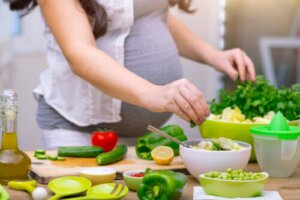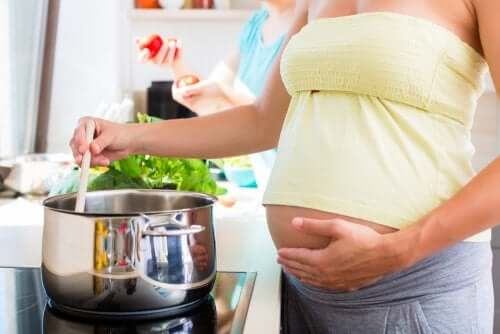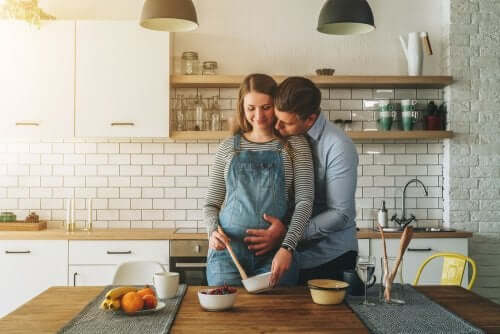Basic Food Safety Rules to Avoid Food Poisoning During Pregnancy

Pregnancy is a stage in a woman’s life when there’s a greater risk of infection from eating certain foods. In addition, the symptoms don’t only affect her, but also her developing child. For this reason, it’s advisable to avoid certain foods as well as follow some basic rules of food safety when handling food. So, let’s take a closer look at how to avoid food poisoning during pregnancy.
What’s food poisoning?
Food poisoning is a set of symptoms that occur as a result of the manipulation and ingestion of food containing microorganisms with the capacity to produce toxins.
The symptoms are usually digestive, although they can also be neurological, renal, or ocular – even miscarriage. For this reason, prevention is fundamental and involves some basic food safety rules that we’ll share with you below.

Basic food safety rules to avoid food poisoning during pregnancy
Wash and disinfect
It’s essential that you wash your hands with soap and water just before preparing food. Also, after going to the bathroom and handling raw food.
In addition, utensils and surfaces must be clean whenever you’re going to use them. This is especially true when alternating between raw and cooked foods. If possible, have different silverware and cutting boards or prepare these foods in different areas. If you’re going to eat raw fruit, vegetables and salads, disinfect them with food bleach to remove any dirt and microorganisms that may be present.
Separate raw and cooked foods, one of the most fundamental food safety standards
The main reason why you should never mix raw and cooked foods is because raw food is a great source of contamination. These are more prone to the development and reproduction of microorganisms due to their high water content. Therefore, the main culprits are vegetables, meat, fish and eggs. And, lastly, dairy products made with raw milk.
Not only does it affect preparation time, but also how you store foods. Be sure to use hermetically sealed containers placed on different shelves and in refrigeration.

Cooking food at the right temperature
By heating food, microorganisms stop reproducing and generating toxins. However, the temperature has to be higher than 160-170 ºC (320-340 ºF) to guarantee their complete destruction.
Cool quickly if consumption isn’t immediate
No food or prepared dish can remain more than two hours at room temperature. At this temperature, microorganisms can grow back. Even if you don’t have a chiller at home (a device that reduces the temperature in minutes), you can cool food using a water bath of cold water with ice.
In addition, this way, you keep the color of the vegetables intact. Once the food’s cold, keep it in the fridge or freezer. Also, cover it well to prevent freezer burn and keep low temperatures from altering the food’s texture and nutritional value.
Finally, remember to follow these basic rules in the kitchen to prevent food poisoning during pregnancy and guarantee your health and that of your future child.
Pregnancy is a stage in a woman’s life when there’s a greater risk of infection from eating certain foods. In addition, the symptoms don’t only affect her, but also her developing child. For this reason, it’s advisable to avoid certain foods as well as follow some basic rules of food safety when handling food. So, let’s take a closer look at how to avoid food poisoning during pregnancy.
What’s food poisoning?
Food poisoning is a set of symptoms that occur as a result of the manipulation and ingestion of food containing microorganisms with the capacity to produce toxins.
The symptoms are usually digestive, although they can also be neurological, renal, or ocular – even miscarriage. For this reason, prevention is fundamental and involves some basic food safety rules that we’ll share with you below.

Basic food safety rules to avoid food poisoning during pregnancy
Wash and disinfect
It’s essential that you wash your hands with soap and water just before preparing food. Also, after going to the bathroom and handling raw food.
In addition, utensils and surfaces must be clean whenever you’re going to use them. This is especially true when alternating between raw and cooked foods. If possible, have different silverware and cutting boards or prepare these foods in different areas. If you’re going to eat raw fruit, vegetables and salads, disinfect them with food bleach to remove any dirt and microorganisms that may be present.
Separate raw and cooked foods, one of the most fundamental food safety standards
The main reason why you should never mix raw and cooked foods is because raw food is a great source of contamination. These are more prone to the development and reproduction of microorganisms due to their high water content. Therefore, the main culprits are vegetables, meat, fish and eggs. And, lastly, dairy products made with raw milk.
Not only does it affect preparation time, but also how you store foods. Be sure to use hermetically sealed containers placed on different shelves and in refrigeration.

Cooking food at the right temperature
By heating food, microorganisms stop reproducing and generating toxins. However, the temperature has to be higher than 160-170 ºC (320-340 ºF) to guarantee their complete destruction.
Cool quickly if consumption isn’t immediate
No food or prepared dish can remain more than two hours at room temperature. At this temperature, microorganisms can grow back. Even if you don’t have a chiller at home (a device that reduces the temperature in minutes), you can cool food using a water bath of cold water with ice.
In addition, this way, you keep the color of the vegetables intact. Once the food’s cold, keep it in the fridge or freezer. Also, cover it well to prevent freezer burn and keep low temperatures from altering the food’s texture and nutritional value.
Finally, remember to follow these basic rules in the kitchen to prevent food poisoning during pregnancy and guarantee your health and that of your future child.
All cited sources were thoroughly reviewed by our team to ensure their quality, reliability, currency, and validity. The bibliography of this article was considered reliable and of academic or scientific accuracy.
- Agencia Catalana de Seguridad Alimentaria (ACSA). Cuatro normas de seguridad alimentaria. Actualizado el 13 de septiembre de 2019. [Consultado el 28 de enero de 2020]. Disponible en: http://acsa.gencat.cat/es/detall/article/Quatre-normes-de-seguretat-alimentaria
- Agencia Catalana de Seguridad Alimentaria (ACSA). La seguridad alimentaria durante el embarazo. Actualizado el 18 de marzo de 2019. [Consultado el 28 de enero de 2020]. Disponible en: http://acsa.gencat.cat/es/seguretat_alimentaria/consells_sobre_seguretat_alimentaria/consells-per-a-embarassades/seguretat-alimentaria-embaras/index.html
- Félix Martín. El libro negro de la seguridad alimentaria en la cocina. (2019) Restauración colectiva books.
This text is provided for informational purposes only and does not replace consultation with a professional. If in doubt, consult your specialist.








